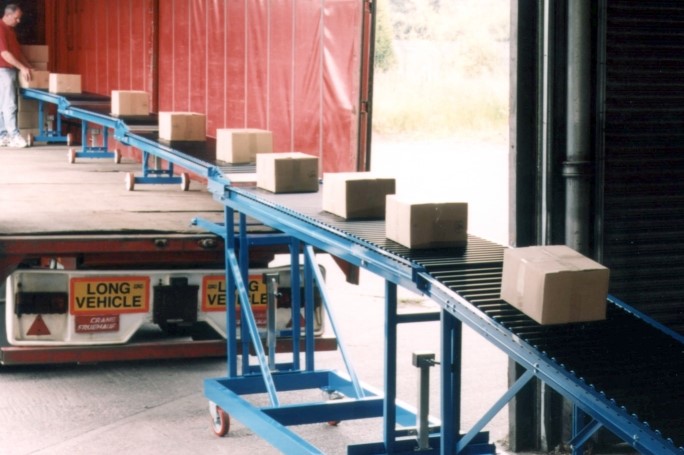
For businesses looking to improve efficiency and save time when unloading freight should look to the benefits of conveyors for the solution. Fixed or mobile conveyors are ideal for the fast and safe handling of various loose items, from parcels to poles! Conveyors are available to fit both dock and dockless loading bays and are designed to reduce any potential packaging damage, as well as reducing the need for excessive manual handling.
Mobile loading conveyors are the perfect choice for truck loading when there is no raised loading dock. They are also perfectly designed for use with smaller vehicles and vans. They help to make the loading/unloading process quicker, safer and smoother as well as helping to adhere to regulation compliance.

Conveyors perfect for unloading processes include:
Flexible powered and gravity conveyor belts – This type of conveyor is available as a tough mobile powered roller, expandable gravity roller or a conveyor with skatewheels. They are an economical choice and can be used for a variety of different handling processes including loose loading and unloading in a warehouse and factory setting. These can also be applied for the linking of both assembly and packaging equipment.
Telescopic conveyors – These conveyors can expand to reach into the rear of a truck or trailer and assist with efficient, rapid loading and unloading of goods. For these and Flexible Conveyors, visit a site like https://fmhconveyors.com/products/flexible-powered-conveyors/
Dockless loaders – The conveyors in this category are ideal for loading and unloading trailers and containers from facilities without a loading dock. They can be applied at multiple door locations.
Of course, there are many risks associated with the unloading and loading of freight. Loading and unloading is not as simple as it sounds. If the right rules are not adhered to, workers can find themselves exposed to hazards.

Some tips for working in a loading bay include:
Staying alert – Waiting for a delivery, it pays to be alert and aware of the surroundings. Are there any unstable platforms, potholes or wobbly ramps that could affect the safety of the unloading process? If there are any conditions like this, it’s a good idea to make a sign to alert other staff to the potential hazard.
Safety with machinery – Machinery like forklift trucks, conveyors and automatic ramps can cause injury or even death if used incorrectly or defective. All machinery should be checked for maintenance before use. Don’t risk using equipment that hasn’t been used for a long time, unless a qualified member of staff has performed a maintenance check first.
Certain types of machinery require qualified staff to operate them. It can be tempting to operate the machines to speed up the process but this should only be done by the relevant staff member trained in this equipment.
Use correct loading system – There are many companies who still load and unload manually which brings a number of physical risks. Automatic systems can often be the safest and most practical method to handle freight in an efficient way, speeding up all associated processes.

